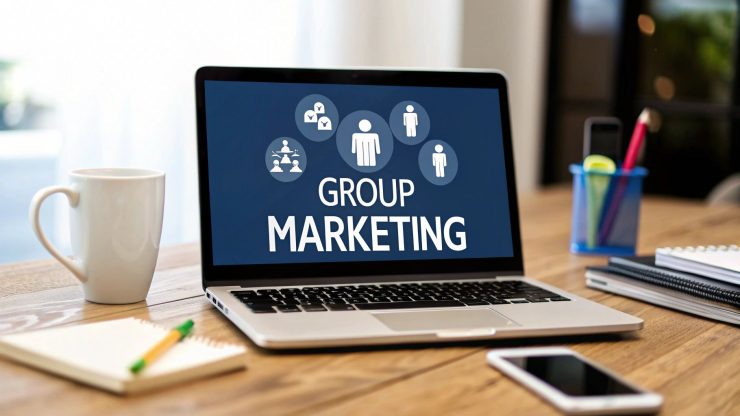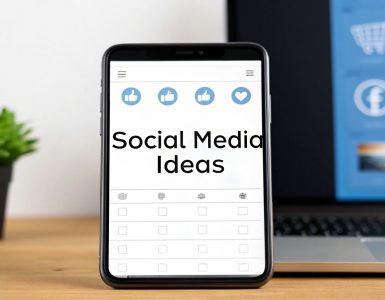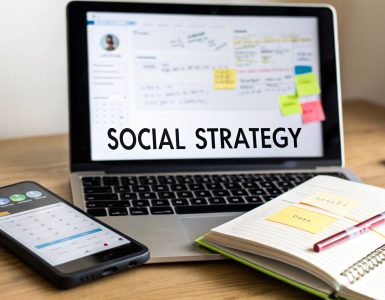Marketing in Facebook Groups isn't about blasting your audience with ads. It's a completely different game—one focused on building real relationships within tight-knit communities. This is how you turn someone who passively follows your page into an active, loyal customer. You do it by showing up, providing genuine value, and building trust where they're already hanging out.
Why Facebook Groups Are a Marketing Goldmine
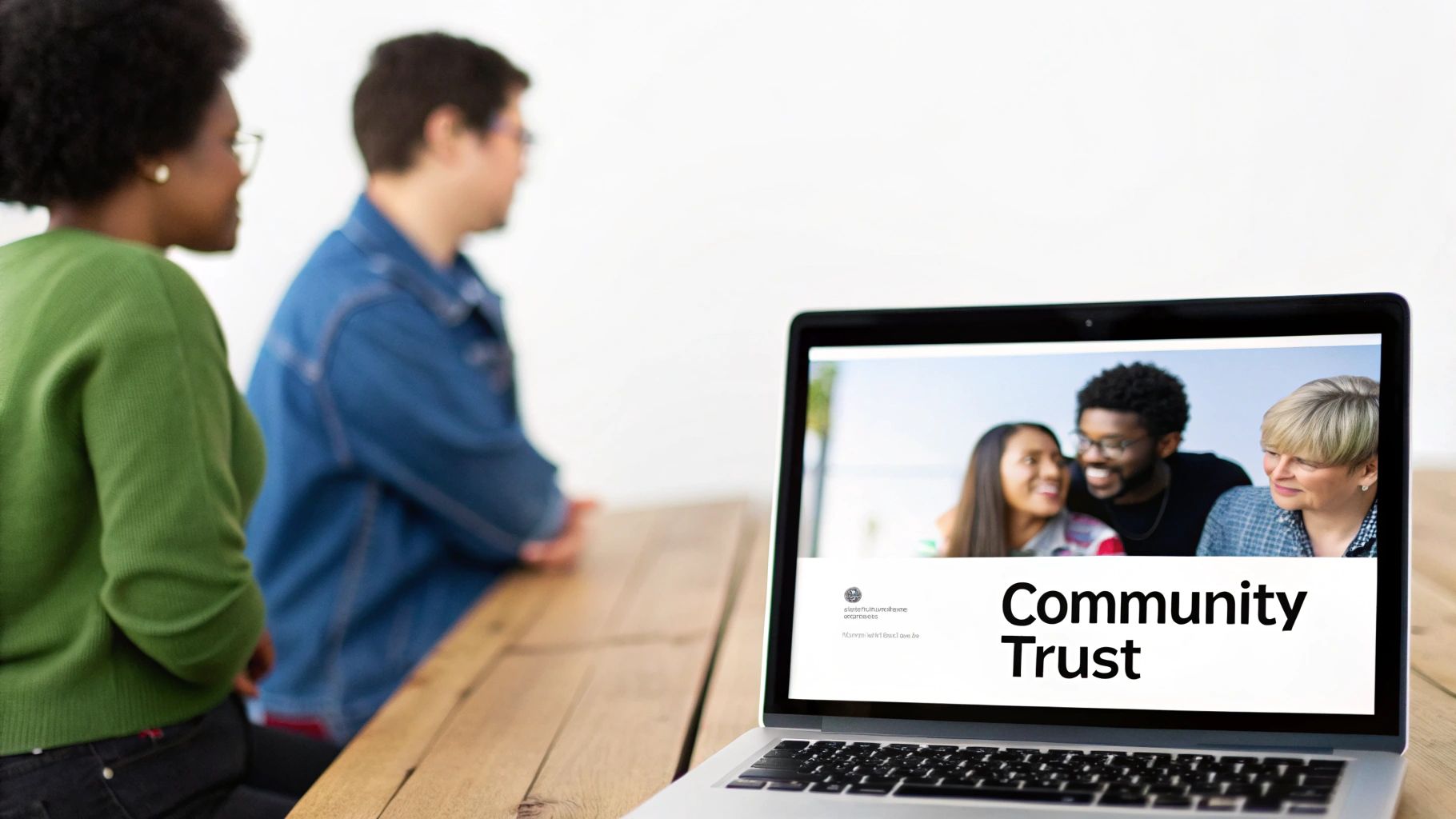
If you feel like your brand’s voice is just getting lost in the endless scroll of the main news feed, you're not imagining things. The real conversations, the ones that build loyalty and drive action, have moved into more focused, private spaces. This is exactly why Facebook Groups need to be a core part of your marketing plan.
Think of these groups as digital campfires. People gather there because they share a common interest, a nagging problem, or a deep passion. It's a fundamental shift from how you operate a public page, where you're essentially speaking at an audience. In a group, you get to speak with a community. That small change in preposition makes all the difference.
The Power of Niche Communities
Let's look at the psychology here. When someone joins a group like "WordPress Speed Optimization," they aren't just killing time. They are actively hunting for solutions and expert advice. They’re pre-qualified, highly engaged, and ready to listen.
This is your opening. It's a golden opportunity to position your brand as a helpful expert, not an annoying advertiser. By consistently showing up with answers, tips, and valuable content, you start to build social currency. That currency is pure trust—the bedrock of any lasting customer relationship.
"Your conversion rate can increase significantly just by including unbiased social proof from group discussions. People want evidence from their peers, not just opinions from a brand. That's the authentic power you tap into."
The scale of this opportunity is staggering. Facebook Groups have become a massive force in digital marketing, with an eye-watering 1.8 billion monthly active users globally as of 2025. To put that in perspective, that's nearly 60% of Facebook’s entire user base actively participating in groups. It’s one of the most vibrant and engaged corners of the platform.
From Broad Reach to Deep Connection
The payoff goes way beyond just getting more eyeballs on your brand. When you're an active participant in relevant groups, you get a direct line into the minds of your target customers. You hear their exact pain points and desires, in their own words.
This hands-on approach delivers some powerful advantages:
- Direct Customer Feedback: You get raw, unfiltered insights into what your audience actually thinks and needs.
- Identify Brand Advocates: You can spot the passionate users who will naturally become your most powerful evangelists.
- Test New Ideas: Thinking about a new product feature or a blog topic? Float the idea in a group and get immediate, honest feedback.
As you dig into why Facebook Groups are such a marketing goldmine, it’s worth understanding Meta's approach to Facebook Groups going public and the nuances of how privacy is evolving. The entire marketing world is shifting away from broad-stroke advertising and toward community-led growth. This is where you'll find sustainable success—it's less about chasing a quick sale and more about building a loyal tribe that will champion your brand for years.
Building Your Facebook Group Marketing Blueprint

Let's be real: jumping into random Facebook Groups and dropping links is a surefire way to get ignored or, worse, banned. To do this right, you need a thoughtful plan that respects the community. Without a solid blueprint, you’re just adding to the noise, not actually building relationships that lead to real results.
Your strategy has to start with defining what success actually looks like for you. Forget vague goals like "get more exposure." We need to get specific. Are you trying to generate 15 qualified leads every month? Maybe your aim is to boost direct traffic to your latest blog post by 25%. Or perhaps the goal is to book three new client consultation calls each week.
Nailing down these tangible goals will guide every single decision you make—from the groups you join to the content you create and share.
Finding and Vetting the Right Groups
One of the biggest mistakes people make is thinking a huge member count equals a valuable group. It doesn't. A ghost town of a group with 50,000 members and zero engagement is completely useless. On the other hand, a smaller, highly active group of 2,000 dedicated professionals can be an absolute goldmine.
When you're scoping out a new group, keep an eye out for these key quality signals:
- Active Discussions: Are members actually talking to each other? Look for posts with real back-and-forth conversations, not just a wall of self-promotional links.
- Engaged Admins: Do the group moderators participate, welcome new people, and keep things on track? A well-managed group is almost always a healthy one.
- Relevant Content: Does what people are talking about line up with your expertise and your audience's problems? If you sell project management software, a group deep in heated debates about agile methodologies is exactly where you want to be.
Before you even think about posting, spend a week or two just observing. Get a feel for the group's culture, learn the inside jokes, and see who the key influencers are. This "lurk before you leap" approach is critical for creating content that actually connects with people.
A group's culture is its unwritten rulebook. If everyone is sharing personal stories and you come in with a cold, corporate-style post, you'll stick out for all the wrong reasons. Match the energy to earn trust.
Structuring Your Content Calendar
Once you’ve found a few promising groups, it's time to build a content plan. You need a smart mix that provides value, sparks engagement, and, yes, promotes your business without being spammy. Just posting whenever you feel like it won’t cut it.
A great place to start is the classic 80/20 rule: 80% of your content should be genuinely helpful and valuable to the community, with only 20% being promotional. This simple ratio helps position you as a go-to expert first and a marketer second.
To avoid being overly promotional, it's crucial to have a clear content mix. I've seen this blueprint work time and time again for keeping a group healthy and engaged while still driving business goals.
Facebook Group Content Mix Blueprint
| Content Type | Posting Frequency Ratio | Purpose | Example |
|---|---|---|---|
| Value Posts | 50% | Educate, solve problems, and build authority. | "I see a lot of people struggling with X. Here are 3 quick tips to fix it…" |
| Engagement Posts | 30% | Spark conversation and build community. | "What's the #1 tool you can't live without for your business? Tell me why!" |
| Personal/Story Posts | 10% | Build connection and humanize your brand. | "Just hit a major milestone and wanted to share the biggest lesson I learned…" |
| Promotional Posts | 10% | Drive traffic, leads, and sales (on approved days). | "For anyone looking to solve [problem], my new guide covers it all. You can grab it here…" |
This kind of intentional mix ensures you're consistently contributing to the community, not just taking from it.
By mapping this out, you can turn your Facebook Group marketing from a scattered, hope-based activity into a reliable system. When you manage this with a tool like EvergreenFeed, you create a predictable engine for generating leads and building your brand reputation.
Keeping Your Content Flowing for Consistent Impact
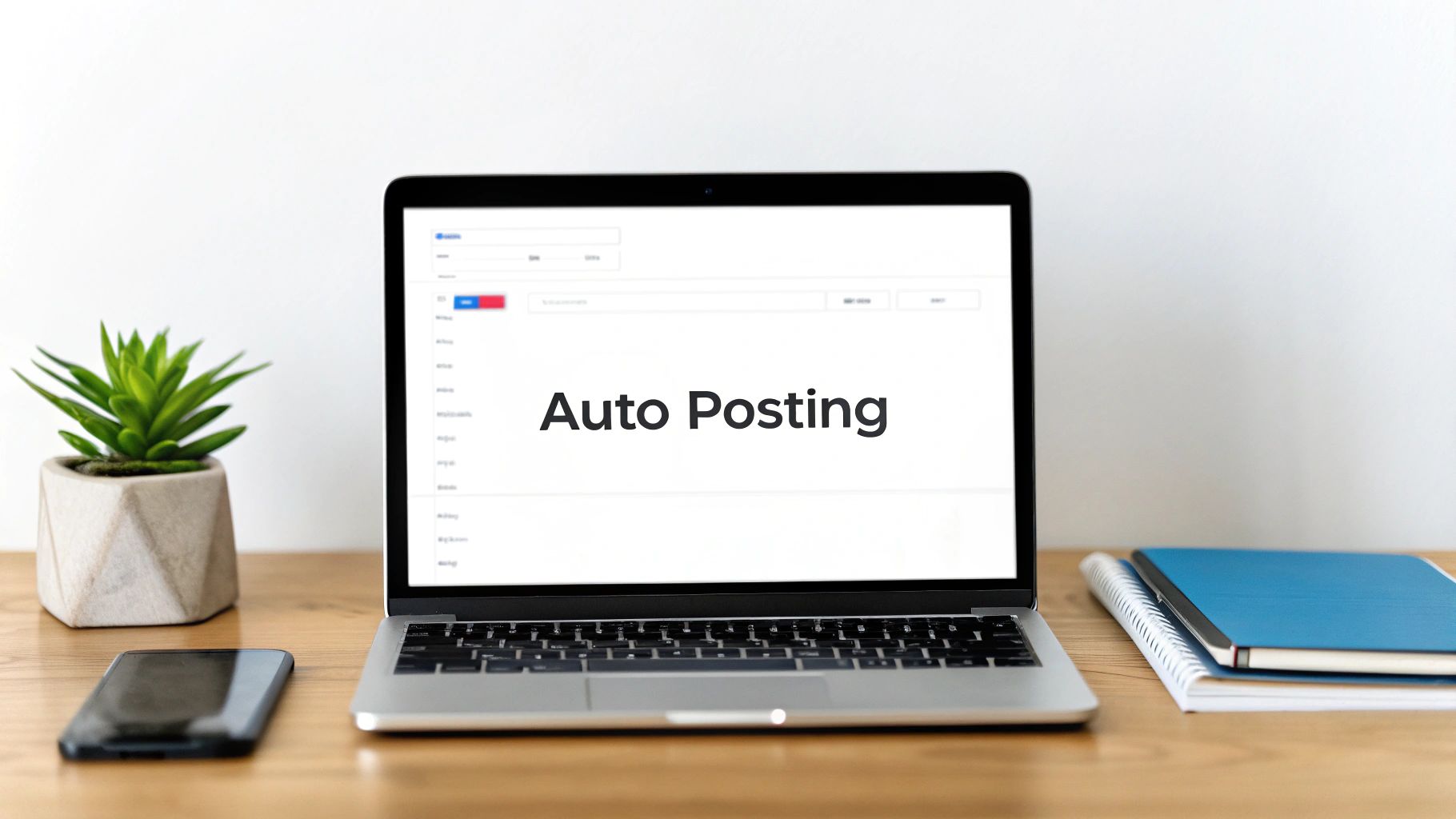
Consistency is the absolute bedrock of a solid Facebook Group marketing strategy. If you only show up here and there, you’ll never build the trust needed to be seen as an expert. But let's be real—manually posting in multiple groups at the best times is a logistical headache that's a fast track to burnout.
This is exactly where automation becomes your secret weapon. Instead of frantically searching for something to post every day, you can build a smart workflow that keeps your brand visible and valuable. It’s all about working smarter, not harder. This frees you up to focus on what really matters—having genuine conversations and building relationships—while your tools handle the heavy lifting.
Build Your Evergreen Content Library
First things first, you need to create a solid library of your best, most timeless content. Think of it as your own personal arsenal of value, ready to be deployed whenever you need it. A tool like EvergreenFeed is perfect for this, as it lets you organize all your posts into different categories, or "buckets."
This isn't just about being organized; it's about strategy. Categorizing your content is the key to maintaining a healthy and balanced mix. You're not just blasting out promotional stuff; you're rotating through different types of value-driven posts that keep your audience engaged.
Start by creating buckets for your main content pillars:
- Expert Tips: Bite-sized, actionable advice that solves a common pain point for your audience.
- Client Wins & Case Studies: Powerful social proof that shows the real-world results you get for people.
- Conversation Starters: Open-ended questions or polls designed to get people talking immediately.
- Blog Post Snippets: Quick teasers that drive curious readers back to your website for the full story.
When you build out these categories, you’re ensuring every single post serves a purpose within your larger marketing plan.
Don't just repurpose old content—give it a refresh. Before you add an older post to your evergreen library, ask yourself: "Is this still 100% relevant and valuable today?" A quick update can make a two-year-old post feel brand new again.
Schedule Your Posts for Peak Engagement
Once your content library is stocked and ready to go, it's time to create a posting schedule that hits when your audience is most active. Every group has its own unique rhythm. A group for entrepreneurs might be buzzing on weeknights, while a B2B professional group could see the most action during weekday lunch breaks.
This is where automation really shines. With a tool like EvergreenFeed, you can set a completely different schedule for each group and even for each content category.
Imagine setting it up like this:
- Conversation Starters: Post these in your top 3 groups every Monday morning to kickstart the week's engagement.
- Expert Tips: Schedule these for Wednesdays and Thursdays, when members are deep in their workweek and actively looking for solutions.
- Promotional Posts: Limit these to Fridays and only in groups that have a dedicated "promo day."
This level of granular control means you're always delivering the right message at the right time, without ever looking spammy or breaking group rules. It's a systematic approach that's becoming even more vital as social commerce grows. In fact, experts predict that 38.5% of Facebook users globally will make a purchase directly through the platform in 2025, highlighting just how powerful community-driven content has become.
By setting up an automated system like this, you create a reliable content engine that runs quietly in the background. It allows you to maintain a powerful, consistent presence, which is the foundation of successful marketing in Facebook Groups. To explore this topic further, check out our guide on how to automate social media posting for maximum efficiency.
How to Craft Posts That Actually Spark Conversations
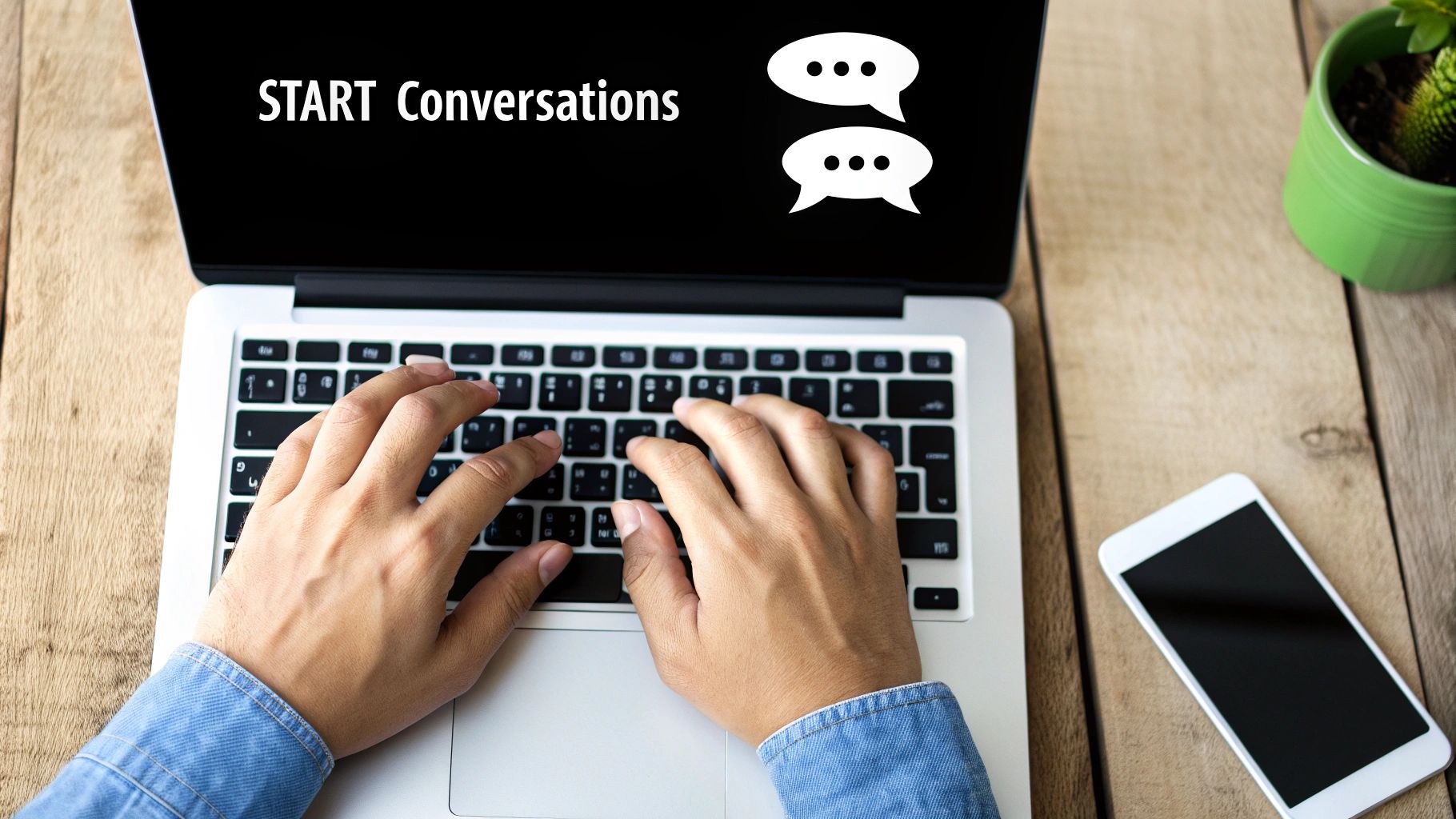
Let's be honest, just showing up in a Facebook Group isn't enough. Your content has to actually earn its place in the feed. The secret to making Facebook Groups work for your business is a mindset shift: stop broadcasting messages and start genuine dialogues.
A post that gets ignored is just digital noise. But one that sparks a real back-and-forth conversation? That's how you build the trust you need.
Your goal should be to create content that’s impossible to just scroll past. This means dropping the corporate jargon and sterile updates. Instead, focus on being human, relatable, and genuinely valuable to the group members. This is how you build the social currency that eventually turns followers into loyal customers.
Ditch the "Yes or No" Questions
We all know asking questions is a classic engagement tactic, but the kind of question you ask changes everything. Closed-ended questions that get a simple "yes" or "no" will kill a conversation before it even begins. You have to ask open-ended questions that pull out stories, opinions, and personal experiences.
So, instead of asking, "Do you use project management software?" try something more engaging like, "What's the one project management tool you absolutely couldn't live without, and what specific feature makes it so essential?"
See the difference? That second one prompts a detailed response and practically invites others to jump in with their own recommendations, creating a lively discussion.
The best engagement posts don't feel like marketing at all. They feel like a curious friend asking for advice. Aim for that tone, and you'll see your interaction rates soar.
Use Polls and Tell Relatable Stories
Polls are a fantastic, low-effort way for members to chime in. They're quick, easy, and give you priceless insight into your audience's heads.
For example, a graphic designer in a small business group could run a poll asking, "What’s your biggest design struggle right now: A) Creating a professional logo, B) Finding quality stock photos, or C) Keeping branding consistent?" The results give you direct feedback for future content, and you can even follow up in the comments to dig deeper.
And never, ever underestimate the power of a good story. Sharing a behind-the-scenes look at a challenge you overcame or a recent client win makes your brand feel real.
Try sharing a few of these:
- A "Before and After" Story: Show a tangible result you delivered for a client, walking people through the process.
- A "Lesson Learned" Post: Talk about a mistake you made and what you learned from it. Being vulnerable builds incredible trust.
- A Personal Milestone: Celebrate a business anniversary or a big achievement. This invites your community to celebrate with you.
These kinds of posts make you memorable and forge a much deeper connection than a standard promo post ever could. If you're looking for more inspiration, you can find a great list of 10 powerful engagement post ideas that are proven to get people talking.
The core idea is simple: stop talking at the group and start talking with them. When you consistently bring value and create space for interaction, you naturally become the go-to expert they know and trust.
Measuring What Matters in Your Group Marketing
Posting consistently is the first half of the battle, but if you're not tracking your results, you’re flying blind. You might be getting likes and comments, but are you getting customers? To really succeed with Facebook Group marketing, you need to know what's actually working.
It’s easy to get caught up in vanity metrics—the likes, the shares, the flood of comments. And while those feel good, they don’t pay the bills. The real trick is to connect your activity in the group directly to business outcomes like new leads, website visits, and, ultimately, sales.
Tracking Clicks and Conversions with UTMs
The single most powerful tool for this is the UTM parameter. Think of it as a little breadcrumb trail you add to the end of your links. These simple tags tell your analytics tools, like Google Analytics, exactly where your website traffic is coming from.
You can create a unique link for every group you post in, or even for a specific post about a new offer. When someone clicks it, you’ll see it in your analytics. This isn't just about knowing your numbers; it’s about making smarter decisions. You’ll quickly discover which groups send the most qualified traffic and which types of posts get people to take action. That data is pure gold when you're loading up your content calendar in a tool like EvergreenFeed, letting you double down on what’s proven to work.
Key Takeaway: Stop dropping naked links in your posts. A simple UTM parameter is the difference between guessing what works and knowing. It creates a powerful feedback loop that lets you improve your strategy with every post.
Combining Quantitative and Qualitative Data
Hard numbers from UTMs tell a crucial part of the story, but don't ignore the human element. The comments section of your posts is a goldmine of qualitative data. What questions are people asking? What specific words are they using to describe their problems? This is your audience telling you exactly what they need.
Pay attention to a few key things:
- Brand Sentiment: Are members talking about you or your brand positively?
- Problem Identification: Do you see the same challenges or frustrations mentioned over and over again?
- Direct Inquiries: Are people sending you DMs or emails asking for more information after seeing a post?
This table breaks down the most important metrics you should be tracking to get a full view of your performance.
Key Performance Indicators for Facebook Group Marketing
A guide to the essential metrics for evaluating the success of your marketing efforts and what each metric tells you about your strategy.
| Metric | How to Track It | What It Indicates |
|---|---|---|
| Click-Through Rate (CTR) | UTM-tagged links in your posts tracked via Google Analytics or bit.ly. | How compelling your call-to-action and post copy are. A low CTR might mean your offer isn't resonating. |
| Conversion Rate | Set up conversion goals in Google Analytics (e.g., lead form submission, purchase). | The percentage of link-clickers who take the desired action. This is the ultimate measure of ROI. |
| Post Engagement | Native Facebook Insights (likes, comments, shares). | How well your content captures attention and sparks conversation. Good for identifying popular topics. |
| Qualitative Feedback | Manually review comments, DMs, and mentions. | Direct insight into your audience's needs, pain points, and perception of your brand. |
By tracking these KPIs, you can move beyond simple post metrics and start evaluating the true business impact of your Facebook Group strategy.
To make sure your efforts are paying off, you need to understand how to measure marketing ROI from a bigger-picture perspective. When you blend the hard data with the human insights, you get a complete view of your impact. For a much deeper dive into this, check out our guide on how to measure social media ROI to tie all your social activities back to your bottom line.
Got Questions About Facebook Group Marketing? Let's Clear Things Up.
Even the best-laid plans can hit a snag when you're dealing with the unique etiquette of Facebook Groups. It's a different world from your business page, and knowing the unwritten rules is crucial for building a great reputation.
Let's walk through some of the most common questions I hear from people trying to get this right.
How Can I Talk About My Business Without Getting Kicked Out?
This is the big one, isn't it? The fastest way to get banned from a group is to treat it like your personal advertising space. Nobody likes that.
The golden rule here is simple: give more than you take. I always recommend an 80/20 balance. For every promotional post you share, you should have at least four other contributions that are purely helpful. Spend 80% of your time just being a valuable member of the community.
That means jumping into conversations, answering questions you have experience with, and sharing helpful tidbits with zero expectation of a return. When you finally do post something about your business, make sure it’s a direct solution to a problem people in the group are actively discussing.
Quick tip: Before you post anything, find and read the group rules. Seriously. Many groups have dedicated "promo days" or specific threads for self-promotion. Respecting those guidelines shows you respect the community, which goes a long way.
This is where a scheduler like EvergreenFeed becomes a lifesaver. You can line up your approved promotional posts for those specific days so you never miss an opportunity, while focusing the rest of your energy on genuine engagement.
Should I Start My Own Group or Just Join Others?
Why not both? They serve completely different, yet complementary, purposes.
- Joining existing groups gives you a massive head start. You get instant access to a built-in audience of people who are already interested in your niche. It’s fantastic for lead generation and building brand awareness right out of the gate.
- Creating your own group is a long-term play. Think of it as building an asset. You get to create a culture, control the conversation, and build a tight-knit community of your most dedicated fans and customers.
Here's an analogy I like: joining other groups is like networking at a conference. Building your own is like hosting it. You can do both! Use established groups to connect with your ideal audience, then gently invite them back to the hub you're building.
How Often Should I Be Posting in a Group?
There's no single right answer here, as it really comes down to the vibe of each specific group. A super active, high-energy group might welcome daily posts, while in a quieter community, that could come across as spammy.
As a general guideline, try to engage with comments and replies daily, but limit your own new posts to 1-3 times per week within any single group you don't own. This keeps you visible without being overwhelming.
What truly matters is consistency, not just sheer volume. Showing up predictably, day after day, builds far more trust than just dropping a bunch of posts once a month and then disappearing.
Ready to apply these strategies without being chained to your desk? EvergreenFeed lets you create a library of your best content and automatically schedules it across your chosen groups. You can maintain that consistent, valuable presence you need while freeing up your schedule. Start automating your evergreen social content for free at https://www.evergreenfeed.com.

